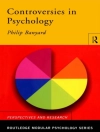This volume analyses the perplexing and often disabling form of distress known as anxiety from a psychological rather than a biomedical perspective, illustrating the rich contribution that psychological theory has made and is making to this topic.**The first section extensively examines the clinical literature, describing and delineating with case examples the cluster of characteristic features termed panic-anxiety. Research findings in other clinical areas such as alcohol dependence are shown to have conceptual and empirical links with panic-anxiety. The second section of the book reviews and evaluates the main theoretical approaches to anxiety, including specific models of panic and agoraphobia, challenging many traditional assumptions and advocating the analysis of anxiety as a socially constructed meaning imposed on experience rather than a theoretical concept or psychopathological state. The methodological implications are discussed and a schematic model of panic-anxiety is proposed.**The theoretical integration represents a major contribution to the resurgence of interest in this field and will be of relevance to all researchers and postgraduate students within the mental health professions.**FROM THE PREFACE: This book has two main objectives. The first is to describe a dimension of psychological distress I have called panic-anxiety. This takes up the first part of the book, which surveys literature that is primarily descriptive and psychiatric. The second objective is pursued in the second part of the book, in which I examine a large number of theories of anxiety to see what they might have to offer in explaining the panic-anxiety cluster of complaints. I am therefore concerned to apply psychological theory to a real-world problem, that is, to what people who seek professional help loosely describe as panic, anxiety and fears of public situations.**The theoretical and experimental literature on anxiety is so vast that I have had to be disciplined and in no small measure prejudiced in favour of a particular theoretical perspective. I have attempted as far as possible to treat anxiety as a lay construct, that is, as a social construction and not a scientific concept. For this reason, I have endeavoured to refer to reports of anxiety or to complaints of anxiety in order to avoid the common tendency to reify anxiety as a an entity which exists independently of the social origins of the term. Accordingly, I believe that the relevant question to ask is not, What is anxiety? but, What are the antecedents of reports (or complaints) of anxiety?**It is intended that this book should provide a coherent perspective on a common form of psychological distress, of value to therapists, researchers and students of abnormal psychology. In many ways, the problems for which people seek help do not define ’natural‘ areas of scientific research, and so it is difficult to combine theoretical and practical interests in one book. The complaints with which I am particularly concerned–panic and fears of public places–can be analysed to reveal scientific questions which have a significance much wider than the explanation of particular complaints made to professionals working in a clinical context. Apart from its obvious social significance, a clinical area is therefore simply a point of departure for scientific investigation. My intention, then, is to use this clinical area as an illustration of how such problems might be tackled from a theoretical perspective which is essentially psychological.**The theoretical position I have adopted owes much to the views of Sarbin (1964, 1968), Mandler (1975) and Averill (1980a, b). In taking anxiety to be a lay construct, I assume that the ‚What is?‘ questions rightly belong to the sociology of knowledge. Of course, the applied psychologist also has substantive issues to consider.
Bozzano G Luisa
Anxiety [PDF ebook]
Psychological Perspectives on Panic and Agoraphobia
Anxiety [PDF ebook]
Psychological Perspectives on Panic and Agoraphobia
Dieses Ebook kaufen – und ein weitere GRATIS erhalten!
Sprache Englisch ● Format PDF ● ISBN 9781483288581 ● Verlag Elsevier Science ● Erscheinungsjahr 2013 ● herunterladbar 3 mal ● Währung EUR ● ID 5736731 ● Kopierschutz Adobe DRM
erfordert DRM-fähige Lesetechnologie












